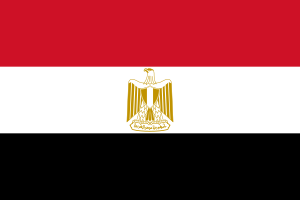Flag of Egypt

 National flag of Egypt (1984-present)
National flag of Egypt (1984-present)The flag of Egypt (Arabic: علم مصر) in its current form was adopted on October 4, 1984. It depicts Egypt's national emblem, the Eagle of Saladin (a shield superimposed on a golden eagle facing the hoist side above a scroll bearing the name of the country in Arabic) centered in the white band of the three equal horizontal bands of red (top), white, and black.
Symbolism
The color red refers to the period before the Revolution which brought a group of army officers to power after deposing King Farouk, the King of Egypt. This was a period characterized by the struggle against the British occupation of the country. The white symbolizes the advent of the 1952 Revolution which ended the monarchy without bloodshed. The color black symbolizes the end of the oppression of the people of Egypt at the hands of the Monarchy and British colonialism.
These colors of the current flag became the traditional Pan-Arab colors, also seen on the flags of Yemen, Syria, and Iraq. The central emblem differs from one country to the other.
Rules Governing the hoisting of the flag
The national flag is hoisted on all governmental buildings on Fridays, official holidays, on the inauguration of the People's Assembly session and other occasions on which the Minister of Interior orders that the flag be hoisted. The flag is hoisted daily on border posts and customs buildings. It is also hoisted on Egyptian consulates and embassies overseas on the National Day and other national occasions, as well as during the visit of the President to the country hosting the diplomatic mission.
To salute the flag, citizens not in uniform stand at attention, with arms and hands to their sides.
Abusing the flag in any way is a criminal offense and is punishable under law as it implies contempt of the power of the state. Penal provisions also govern abuse of foreign flags or national emblems of other countries.
History

 Egypt under Ottoman Empire during the 19th century.
Egypt under Ottoman Empire during the 19th century.
 The Egyptian flag under the Muhammad Ali Dynasty (1805–1922).
The Egyptian flag under the Muhammad Ali Dynasty (1805–1922).Muhammad Ali Dynasty (1805–1922)
To signify his autonomy from the Ottoman Porte, and his own grandiose ambitions of challenging the Sultan for control of the Ottoman Empire itself, Muhammad Ali introduced a flag highly reminiscent of the Ottoman flag, with three white crescents and three stars on a red field. It has been suggested that this was to symbolize the victory of his armies in 3 continents (Africa, Asia, and Europe), or his own sovereignty over Egypt, Nubia, and Sudan.
After the Urabi Revolt in 1882, British forces occupied the country, igniting ever greater nationalist resentment. This reached a peak in the Revolution of 1919, when both the red Muhammad Ali flag, and a special green banner bearing a crescent and cross (to show that both Muslims and Christians supported the nationalist movement against British occupation) were seen in the streets.

Kingdom of Egypt (1922–1952)
The first official national flag of modern Egypt was adopted by a Royal Decree of the Kingdom of Egypt in 1923, after Britain formally recognized Egyptian independence in 1922. It consisted of a white crescent with three white stars on a green background.
The three stars supposedly represented either the three parts comprising the Kingdom (Egypt, Nubia and Sudan), or the three religious communities of Egypt: Muslims, Christians and Jews.

Republic of Egypt (1952–1958)
Following the 1952 Revolution, the republic initially kept the green flag with the crescent and three stars of the kingdom but later replaced it with a red-white-black horizontal tricolour like today, but with a different style of eagle emblem in the white stripe, bearing a shield of the crescent and stars. It has since seen only changes to the central emblem: under the United Arab Republic (1958-1971), the white stripe contained two green stars; in 1972-1984, a Golden Hawk of Quraish; and since 1984, the Eagle of Saladin with a superimposed shield, and a scroll bearing the country's name in Arabic.

 United Arab Republic - Egypt and Syria (1958–1961), flag used until 1972.
United Arab Republic - Egypt and Syria (1958–1961), flag used until 1972.Egypt as United Arab Republic (1958–1972)
In 1958, a Presidential Decree established a new flag for the United Arab Republic which comprised a merger of Syria and Egypt.
Egypt continued to use this flag until January 1, 1972, although the short-lived union saw its dissolution in 1961.

 The flag of the Republic of Egypt (1972–1984)
The flag of the Republic of Egypt (1972–1984)Republic of Egypt (1972–1984)
In 1972, when Egypt joined the Federation of Arab Republics, the Law was amended to change the flag. The stars were removed from the flag and replaced by a golden hawk (the "Hawk of Qureish"), holding a scroll with the Arabic name of the Federation.
The change in 1984, in addition to restoring the Eagle of Saladin, restored the top red stripe to the same red used in the United Arab Republic flag. The flag of 1972 had lightened the red color slightly.
See also
External links
